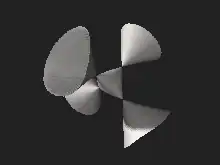Cayley's nodal cubic surface
In algebraic geometry, the Cayley surface, named after Arthur Cayley, is a cubic nodal surface in 3-dimensional projective space with four conical points. It can be given by the equation


when the four singular points are those with three vanishing coordinates. Changing variables gives several other simple equations defining the Cayley surface.
As a del Pezzo surface of degree 3, the Cayley surface is given by the linear system of cubics in the projective plane passing through the 6 vertices of the complete quadrilateral. This contracts the 4 sides of the complete quadrilateral to the 4 nodes of the Cayley surface, while blowing up its 6 vertices to the lines through two of them. The surface is a section through the Segre cubic.[1]
The surface contains nine lines, 11 tritangents and no double-sixes.[1]
A number of affine forms of the surface have been presented. Hunt uses by transforming coordinates to and dehomogenizing by setting .[1] A more symmetrical form is
References
- Hunt, Bruce (1996). The Geometry of Some Special Arithmetic Quotients. Springer-Verlag. pp. 115–122. ISBN 3-540-61795-7.
- Weisstein, Eric W. "Cayley cubic". MathWorld.
- Cayley, Arthur (1869), "A Memoir on Cubic Surfaces", Philosophical Transactions of the Royal Society of London, The Royal Society, 159: 231–326, doi:10.1098/rstl.1869.0010, ISSN 0080-4614, JSTOR 108997
- Heath-Brown, D. R. (2003), "The density of rational points on Cayley's cubic surface", Proceedings of the Session in Analytic Number Theory and Diophantine Equations, Bonner Math. Schriften, vol. 360, Bonn: Univ. Bonn, p. 33, MR 2075628
- Hunt, Bruce (2000), "Nice modular varieties", Experimental Mathematics, 9 (4): 613–622, doi:10.1080/10586458.2000.10504664, ISSN 1058-6458, MR 1806296
External links
- Cayley’s Nodal Cubic Surface, John Baez, Visual Insight, 15 August, 2016
- Cayley Surface on MathCurve.